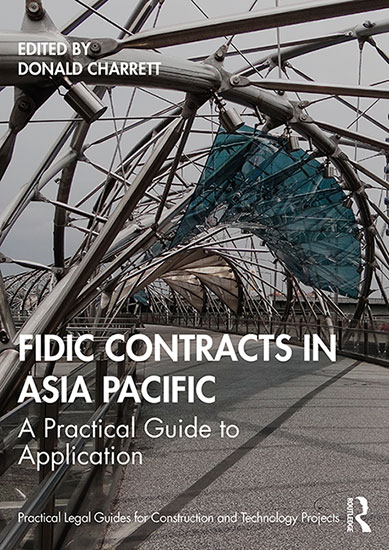FIDIC Contracts in Asia Pacific – A Practical Guide to Application

FIDIC Contracts in Asia Pacific – A Practical Guide to Application
by Donald Charrett
Published by: Routledge
ISBN: 9781032061436
598 pages, £150
Publication date: November 2021
Reviewed by Kiri Parr, Vice-Chair of International Federation of Consulting Engineers (FIDIC) Contracts Committee, independent consultant and academic
In 2020 Dr Charrett published The International Application of FIDIC Contracts for which I wrote a review. At the end of that review I noted that ‘we should all keep our eyes out for future editions of this text as it keeps up with local changes in law and hopefully expands to include even more countries’.[1]
Well, Dr Charrett has demonstrated his industriousness by the publication, just a year later, of the next book in the series: FIDIC Contracts in Asia Pacific.
The book largely follows the same structure as the previous text, focusing on 16 countries across the Asia Pacific region: Australia, China, Fiji, Hong Kong, India, Indonesia, Japan, Malaysia, Nepal, Pakistan, Papua New Guinea, the Philippines, Singapore, Sri Lanka, South Korea and Vietnam.
The authors of each country chapter are all highly regarded and it is testament to the value of this book that it is so well supported by the region’s legal community. Their detailed jurisdiction-based analysis provides users of these contracts with an in-depth understanding of the legal issues that affect a contract’s interpretation and application, including in the areas of governing law and dispute resolution.
The subject matter of the book is clearly defined in the introductory chapter of the book as the standard form Conditions of Contract published by the Federation Internationale des Ingineurs–Counsels (FIDIC), known in English as the International Federation of Consulting Engineers.
The introduction explores the FIDIC suite of contracts, the underlying drafting principles and their operation across both common law and civil jurisdictions.
Chapter 2 explores one of the key contextual pieces for the FIDIC Contracts: the FIDIC Golden Principles. In short, these principles are the fair and equitable allocation or risk between the parties, clear definition of scope, duties, roles, rights and responsibilities, and contract documents that constitute a contract management manual for best practice international project execution. As Bill Howard, FIDIC President 2019–2020, points out in the foreword:
‘I am especially pleased to note that Donald has included in this book a chapter on the FIDIC Golden Principles. In the complex world global firms practicing in the infrastructure space, their clients and the various funding agencies they work with operate in, there is a need to delineate some basic principles regarding the use of FIDIC Conditions of Contract. These Golden Principles address this need, and we encourage everyone to follow. We firmly believe that following these five principles will dramatically increase the probability of a successful project. The principles are designed to protect everyone’s interests. We respectfully suggest that not following them can lead to serious project problems as well as negatively albeit unfairly impact the perception of FIDIC’s Conditions of Contract. Thus, we strongly encourage everyone to follow them and, again, are pleased that Donald has featured them in the text.’
Each jurisdiction’s chapter specifically considers:
• the legal environment of that jurisdiction;
• the construction industry in that jurisdiction;
• the impact of Covid-19 on the execution of construction projects and the operation of construction contracts;
• the applicable legislation, if the governing law is of that jurisdiction, considering both constraints on the governing law of a construction contract and any formal requirements;
• which special provisions in the particular conditions are necessary for consistency with applicable laws;
• which special provisions are desirable for consistency with the applicable laws;
• applicable legislation if the governing law is of that jurisdiction;
• applicable legislation if the site/country is in the jurisdiction;
• applicable legislation if the ‘seat’ of the dispute or determination is of that jurisdiction;
• issues that a court or arbitrator may construe differently to that expected from the words of the contract because of local law or custom; and
• reference material.
The specific questions crafted by the editor and which are addressed for each jurisdiction provide a high level of consistency and discipline across the book, which highlights the value and importance of local knowledge and advice.
The sections on the construction industry in each jurisdiction are a new component. They provide unique insight into the history and drivers of the construction industry in each country as well as the challenges they face. For example, the chapter on China’s construction industry discusses the uncertainty which has emerged since rules relating to the participation of foreign contractors in China were abolished in 2020.
As a sign of the times, each of the country summaries specifically covers the impact of Covid-19 on the execution of construction projects and the operation of construction contracts. A review of these sections reveals how the pathways through Covid-19 are varying greatly from country to country. Impacts of mobility of international expertise is a recurring theme and it is interesting to observe the wide range of government responses and interventions.
Overall, the detailed and exhaustive analysis of the law of each of the jurisdictions considered in this book provides an invaluable resource from which to approach the task of drafting or reviewing Particular Conditions to the FIDIC Suite of Contracts as well as to any other construction contract in that jurisdiction.
For construction lawyers practising in the Asia Pacific region, this book provides a ready guide and insight into the laws of the region.
I can highly commend this book on multiple levels – from its intention to provide a practical tool by which to draft the Particular Conditions to a FIDIC Contract to its secondary benefits providing invaluable insight into the operation of construction law and the context in which projects are delivered across the region.
Note
[1] (2020) 193 Australian Construction Law Newsletter 58.